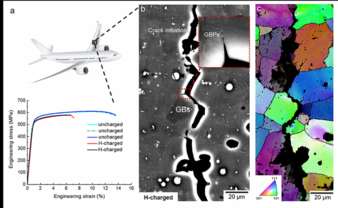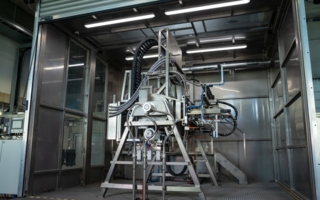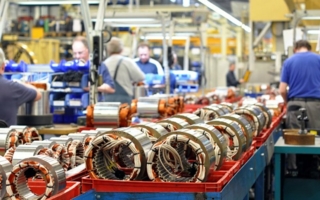17/03/2022 – Research results of the Max-Planck-Institute for Iron Research
How hydrogen behaves in aluminium alloys
Due to its low density, high strength, and abundance, aluminium and its alloys are widely used for example in constructions, consumer electronics and for vehicles including cars, ships, trains and planes. However, aluminium alloys are prone to hydrogen embrittlement causing catastrophic failure during service if not noticed early enough. Compared to steel, the effects of hydrogen in aluminium are not well understood.

Fig. 1: Tensile properties and metallographic fractography of an aluminium-based alloy with zinc, magnesium and copper after aging for 24 hours at 120°C. a) Engineering stress–strain curves of uncharged and hydrogen-charged samples. b and c) Electron imaging of an intergranular crack of the hydrogen-charged alloy subjected to tensile fracture. © MPIE
Dr. Huan Zhao, postdoctoral researcher at the Max-Planck-Institut für Eisenforschung (MPIE), and her colleagues analysed how hydrogen embrittles aluminium alloys and found first approaches of hindering this effect. The scientists now published their latest results in the journal Nature.
Grain boundaries play a major role in embrittlement effect
“As hydrogen is the smallest of all elements and has low solubility in aluminium, it is extremely challenging to detect on the atomic scale. Whether and how much hydrogen enters aluminium? Where is it located inside the microstructure and how does it affect the properties? All these were unsolved questions till now”, explains Zhao. The MPIE researchers used so-called 7xxx aluminium, a high-strength aluminium class that is the primary material of choice for structural components of airplanes. They charged their samples with hydrogen and performed tensile tests showing that the ductility decreases with increasing amounts of hydrogen.
The fracture surface showed that cracks especially propagated along grain boundaries. Through the cryo-transfer atom probe tomography the scientists revealed that hydrogen gathered along those grain boundaries. “Our experiments were able to show that the amount of hydrogen at particles inside the bulk is much higher than at grain boundaries. However, hydrogen embrittles the material only at the grain boundaries. With the help of computational simulations, we were able to see that hydrogen is attracted by the high energy regions along the grain boundaries causing material’s failure and that particles in the bulk rather act as hydrogen traps, which hinder crack propagation.”, says Dr. Poulami Chakraborty, co-author of the recent publication and postdoctoral researcher at the MPIE.
Intermetallic particles could be a first solution
The MPIE researchers were able to show where hydrogen is located following its ingress during the material’s processing or in service. As this cannot really be prevented, it is important to control its trapping. They recommend different strategies to prevent hydrogen embrittlement, in particular through the use of intermetallic particles that could trap hydrogen inside the bulk material. Additionally, control of the magnesium level at grain boundaries appears critical. “Magnesium paired with hydrogen at grain boundaries increases the embrittlement”, says Zhao. “At the same time, we must manipulate the correct size and volume fraction of particles in the bulk to trap hydrogen while maintaining the material’s strength.” Further studies on the ‘perfect’ particle distribution and eliminating magnesium decoration of grain boundaries are pursued to design advanced high strength, hydrogen-resistant aluminium alloys.
The research was partly funded through the consolidator grant “Shine” of the European Research Council. The project is headed by Prof. Baptiste Gault, group leader at the MPIE and co-author of the recent publication.
The international team of the Max-Planck-Institut für Eisenforschung conducts advanced basic materials research for the fields of mobility, energy, infrastructure, medicine and digitalisation. The focus lies on nanostructured metallic materials as well as semiconductors, which are analysed down to their atomic and electronic scales. This enables the MPIE team to develop new, tailor-made structural and functional materials embracing their synthesis and processing, characterization and properties, as well as their response in engineering components exposed to real operating environments.
GB: grain boundary; GBPs: grain boundary precipitates. In Nature, 10.1038/s41586-021-04343-z.
Original publication: H. Zhao, P. Chakraborty, D. Ponge, T. Hickel, B. Sun, C.H. Wu, B. Gault, D. Raabe: Hydrogen trapping and embrittlement in high-strength Al-alloys. In: Nature, 10.1038/s41586-021-04343-z
Max-Planck-Institut für Eisenforschung GmbH
Max-Planck-Strasse 1, 40237 Düsseldorf, Germany
Contact person is Yasmin Ahmed Salem
Tel.: +49 211 6792-0
y.ahmedsalem@mpie.de
www.mpie.de


